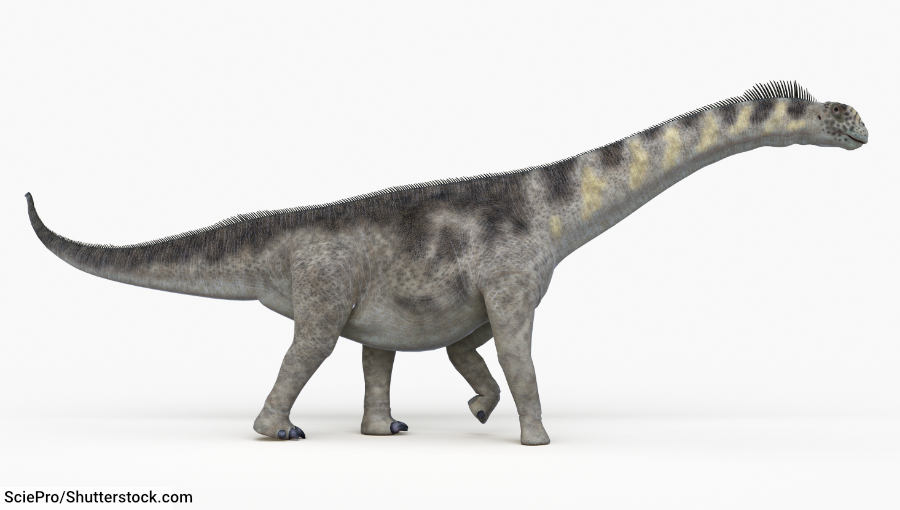Camarasaurus, known for its distinctive box-like skull and robust body, was a sauropod dinosaur that lived in North America during the Late Jurassic period. It is the most commonly-found sauropod in the Morrison Formation, a famous dinosaur fossil site in the western United States.
Camarasaurus Facts
- Type of Dinosaur: Sauropod
- Diet: Herbivore
- Continent(s) Found: North America
- Length: Approximately 15–18 meters (49–59 feet)
- Height: Approximately 4.5–6 meters (15–20 feet)
- Weight: Approximately 23–40+ metric tons (25–44+ tons)
- Period: Late Jurassic (about 155 to 145 million years ago)
What Did Camarasaurus Look Like?


Camarasaurus was a large, robust sauropod dinosaur, easily recognizable by its distinctive box-like skull and large, rounded nasal openings located in front of its eyes.
Although long, the neck of Camarasaurus was shorter and sturdier than that of some other long-necked sauropods.
Typically for a sauropod, the body of Camarasaurus was massive and barrel-shaped, supported by thick, pillar-like legs.
Like other members of the family Camarasauridae, its forelimbs were slightly shorter than its hind limbs, giving its back a slight arch. The tail was longer than the neck, and helped balance its large body.


Camarasaurus measured approximately 15 to 23 meters (49 to 75 feet) in length and stood about 4.5 to 6 meters (15 to 20 feet) tall at the hips. Its weight is estimated to have been around 23 metric tons (25 tons) – although some estimates of its maximum weight are in excess of 40 metric tons / 44 tons.
Although direct fossil evidence of its skin is rare, it is believed that Camarasaurus had a rough, scaly texture, typical of many sauropods. This impressive size and unique physical features made Camarasaurus a dominant herbivore in its ecosystem during the Late Jurassic period.


Camarasaurus Fossils
Camarasaurus is one of the most common dinosaurs in the fossil record, with over 500 Camarasaurus specimens having been discovered. A specimen of a juvenile Camarasaurus is one of the most complete sauropod fossils yet discovered.
Camarasaurus Species
Currently, four Camarasaurus species have been identified:
- Camarasaurus grandis
- Camarasaurus lentus
- Camarasaurus lewisi
- Camarasaurus supremus
What does the name Camarasaurus mean?


The name “Camarasaurus” means “chambered lizard.” It is derived from the Greek words “kamara,” meaning “vaulted chamber,” and “sauros,” meaning “lizard.”
This name refers to the dinosaur’s distinctive vertebrae, which had hollow chambers. These hollow spaces in the vertebrae made the bones lighter while maintaining strength, a useful adaptation for supporting the massive size of this dinosaur.
The hollow bones contained air sacs, which enabled the dinosaur to take in enough oxygen to keep its huge body functioning.
Camarasaurus was first named and described in 1877 by the paleontologist Edward Drinker Cope.
What Type Of Dinosaur Was Camarasaurus?
Camarasaurus was a sauropod and a member of the family Camarasauridae, characterized by their relatively short and robust necks, large nasal openings, and spoon-shaped teeth.
Where Did Camarasaurus Live?
Camarasaurus lived in what is now North America. Fossils of Camarasaurus have been predominantly found in the Morrison Formation, a rich dinosaur fossil site that spans several states in the western United States, including Colorado, Utah, Wyoming, Montana, New Mexico, and Oklahoma.
When Did Camarasaurus Live?
Camarasaurus lived during the Late Jurassic period, approximately 155 to 145 million years ago. This time frame places Camarasaurus in an era when North America was home to a diverse array of large dinosaurs, including other notable sauropods like Diplodocus and Brachiosaurus.
What Dinosaurs And Other Animals Did Camarasaurus Live With?
Camarasaurus shared its habitat in the Morrison Formation during the Late Jurassic period with a diverse range of dinosaurs and other prehistoric animals. This period, approximately 155 to 145 million years ago, was rich in both herbivorous and carnivorous dinosaurs, as well as various other fauna.
Dinosaurs that lived with Camarasaurus:
- Sauropods: Camarasaurus coexisted with other large sauropods such as Diplodocus, Apatosaurus, and Brachiosaurus. These sauropods, like Camarasaurus, were herbivores and occupied different ecological niches.
- Theropods: Large predatory dinosaurs, including Allosaurus and Ceratosaurus, were among the top carnivores. They preyed on the abundant herbivorous dinosaurs.
- Ornithopods: These included smaller herbivores like Dryosaurus and Camptosaurus, which were agile and likely fed on low-growing vegetation.
- Stegosaurs: Stegosaurus was a well-known armored dinosaur from this period, recognized for its distinctive back plates and tail spikes.
- Ankylosaurs: Although less common, some early ankylosaurs like Mymoorapelta were present.
Other animals that lived with Camarasaurus:
- Pterosaurs: Several pterosaurs would have been seen flying in the Jurassic skies at the time Camarasaurus was alive. These include Harpactognathus and Kepodactylus.
- Crocodyliforms: Early relatives of modern crocodiles, like Goniopholis, lived in the rivers and lakes of the region.
- Amphibians: Eobatrachus, an early frog, and Iridotriton, and early salamander, are examples of amphibians found in the Morrison Formation.
- Mammals: Small mammals, mostly nocturnal, such as docodonts and multituberculates, coexisted with dinosaurs, living in burrows and feeding on insects and small plants.
- Fish and Invertebrates: The rivers and lakes teemed with fish, while the land and water supported a range of invertebrates like insects, mollusks, and crustaceans.
Discover More About Dinosaurs With Active Wild
Visit our main dinosaur page for dinosaur facts, pictures, in-depth information and lists: Dinosaurs – The Complete Guide

